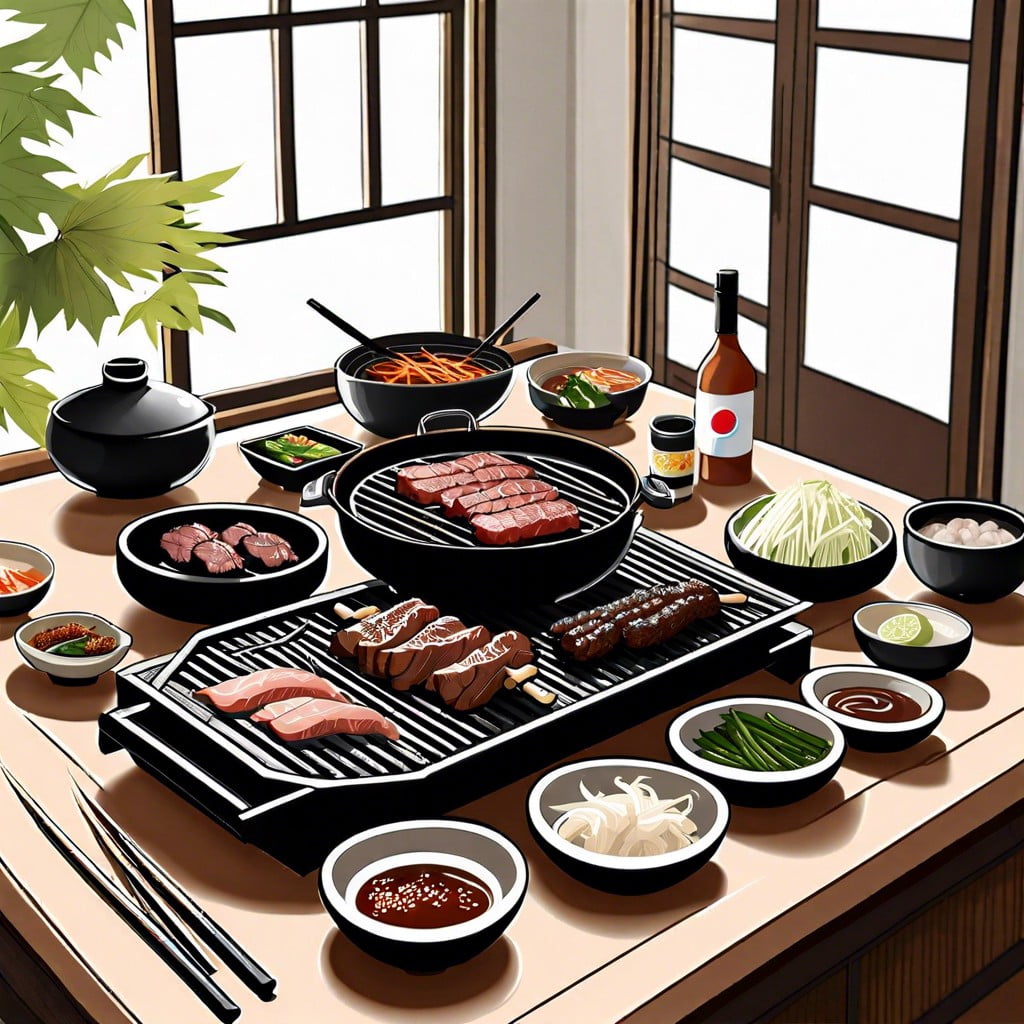Discover how to recreate authentic Korean BBQ at home with these simple steps that will guide you through choosing the right ingredients, equipment, and techniques.
Key takeaways:
- Korean BBQ is an interactive and enjoyable dining experience.
- Traditional gas or charcoal grills work best for authentic flavors.
- Rib eye, sirloin, pork belly, and chicken thighs are popular meat choices.
- Banchan (side dishes) like kimchi and cucumber salad complement the BBQ.
- Dipping sauces like ssamjang and cho-gochujang enhance the flavors.
What Is Korean BBQ & Why You Should Try It At Home

Korean BBQ, also known as gogi-gui, is a popular culinary practice that involves grilling meat, usually beef, pork, or chicken, directly at the dining table. The interactive style of cooking and communal eating makes it an enjoyable experience for groups and families alike.
What sets it apart from other BBQ traditions is the use of unique cuts, such as bulgogi (thinly-sliced marinated sirloin) and galbi (marinated short ribs), combined with a diverse array of flavorful side dishes known as banchan.
Having Korean BBQ at home offers several benefits. It allows for customization of flavors and ingredients to suit personal preferences. Additionally, controlling the quality of meat and the balance of sides ensures a healthier meal. Furthermore, hosting a Korean BBQ is a social and engaging way to entertain guests, making it an adventure in both cooking and cultural exploration.
The Best Grill for Korean BBQ
Selecting an appropriate grill is key to mimicking the authentic Korean BBQ experience at home. The traditional choice is a portable gas grill with a convex griddle top, designed to channel away excess fat while still allowing the meat to cook in its flavor-packed juices.
For a more authentic touch, consider a charcoal grill. The unique smoky aroma imparted by charcoal cannot be matched by gas grills and it comes closest to what you might find at a restaurant in Seoul.
Electric grills are also an option, particularly for apartment dwellers or those with limited outdoor space. Many are specifically made for Korean BBQ, featuring grooved plate designs to replicate the grilling style.
Regardless of heat source, the grill surface should be non-stick for easy flipping and cleanup. Infrared grills can provide even heat distribution and a faster cooking time, which comes in handy for hosting gatherings.
Size matters when choosing your grill; it should be large enough to accommodate multiple pieces of meat but small enough to enable diners to reach and cook their own food, enhancing the communal dining experience.
Accessories, such as tongs and scissors, should also be considered for a complete Korean BBQ setup, allowing guests to cut and turn meat without the need for additional utensils.
Best Types of Meat for Korean BBQ
Selecting the right cuts can elevate your Korean BBQ experience. Thin slices of beef, specifically rib eye or sirloin, are popular choices as they cook rapidly and absorb marinades well.
Pork belly, with its rich flavor and succulence, is another favorite, ideal for achieving a crispy yet tender texture.
For those preferring lighter fare, chicken thighs offer the perfect canvas for bold Korean flavors, retaining juiciness throughout grilling.
With each of these meats, ensure they’re cut against the grain for maximum tenderness. Additionally, marinating meat in a mixture of soy sauce, sugar, sesame oil, garlic, and green onions can impart authentic Korean BBQ flavors before it even hits the grill.
Side Dish Ideas (banchan)
Complementing your Korean BBQ with a variety of banchan, or side dishes, elevates the entire dining experience.
Kimchi, arguably the cornerstone of banchan, brings a pungent, spicy kick that cuts through the richness of grilled meats. Prepare it well in advance, as it needs time to ferment and develop its signature flavor.
Cucumber salads deliver a refreshing crunch and a vinegar-based dressing balancing the meal’s umami and fat elements. Quick pickled cucumbers can be made in less than thirty minutes, offering a swift solution for a palate-cleansing side.
Bean sprout salad, seasoned with sesame oil, provides a nutty, light accompaniment. Its simplicity ensures that it doesn’t overshadow the main event.
Sautéed spinach, lightly wilted and seasoned with garlic, is a quick, healthy addition that delivers a soft texture contrast against the char of the meat.
For a starch component, consider Japchae, a savory glass noodle dish with vegetables, that pairs seamlessly with BBQ by absorbing meat juices and sauce flavors.
These banchan not only offer a range of tastes and textures but also contribute to the communal spirit of Korean BBQ, allowing guests to mix and match for a personalized dining experience.
Korean BBQ Dipping Sauces
Elevating the flavors of any Korean BBQ meal, dipping sauces are pivotal. They vary in complexity from simple salt and pepper in sesame oil to the more intricate gochujang-based sauces. Here are some traditional options:
1. Ssamjang: A thick, spicy paste made from gochujang (red chili paste), doenjang (fermented soybean paste), sesame oil, onion, garlic, and sugar. It complements the savory flavors of grilled meats wonderfully.
2. Gireumjang: For those who prefer subtlety, this is a simple mix of salt, black pepper, and toasted sesame oil. It’s perfect for dipping thinly sliced meats, enhancing their natural flavors without overwhelming them.
3. Cho-gochujang: A vibrant, tangy sauce combining gochujang, vinegar, and sugar. Ideal for a refreshing contrast that cuts through the richness of the meat.
4. Sesame Salt (Ggomjang): A nutty and salt forward choice, this blend of ground toasted sesame seeds and salt is the definition of simplicity.
When making these sauces, balance is key. Adjust the level of sweetness or spice to cater to your personal taste. Serving multiple sauces allows guests to customize their experience and discover their preferred combinations.

